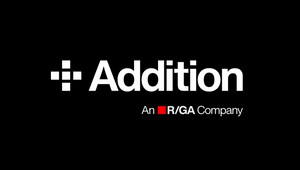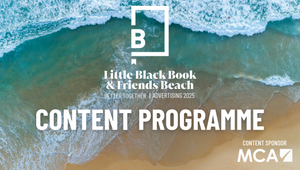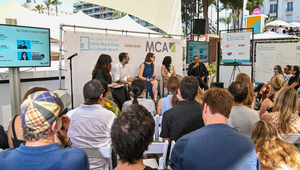
Ad Astra: Tiffany Rolfe, the Inventor at the Intersection

Rifling around under the hood of a problem is where Tiffany Rolfe loves to be.
R/GA’s global chief creative officer is recalling poring over court documents from old lawsuits for an anti-smoking campaign she worked on years ago. These days, the constraints of time and the plethora of information online, not to mention real time data available, means that lugging around dusty binders laden with clues is a nostalgic memory. But that desire to dig, to find the pieces, to figure out how they fit and how they can be rearranged is just as vital today. It’s an inventor’s mind that seeks to understand how things work and to use that knowledge to build something new. It makes sense, then, to learn that before pursuing a creative career, Tiffany turned down a scholarship to study science and engineering. These days the ‘how’ of things fuels her thinking on everything, from the way she thinks about the impact of technology on the way we work to her personal predilection for neuroscience podcasts.
“There’s something about really digging into a business challenge… I love that part of it because that’s where I find inspiration,” she says. “I want to put the pieces together. You find all the kernels of understanding something deeper. It helps you. You don’t even realise how, but it helps your brain put the pieces together. It helps the work to be more true, more connected to what the problem is.
“You have to nerd out a little bit within each one of our clients to do meaningful work that does solve real problems.”
Nerding out for Tiffany isn’t just an exercise in esoteric brainfood. There’s a business imperative too. The insatiable curiosity about science, engineering and human behaviour intersects with entrepreneurialism and creativity, and it’s a powerful cocktail.
That entrepreneurialism goes way back. Tiffany’s grandmother - an artist and the publisher of an art magazine - was the model of creativity-meets-business. She would take young Tiffany to art competitions, where she soon cottoned on to the idea that her drawings and paintings could win her soft toys and cash… in other words, that creativity was valuable. It’s an insight the pair continued to share - as Tiffany’s advertising career blossomed and her work began to win awards, her grandmother, then in her 80s, would proudly share the commercials she had created for local businesses.
“So, she’s a little competitive,” Tiffany says fondly, “I get that from her.”
A theatre kid at school, when Tiffany left home, it was to Los Angeles that she headed. It took just a couple of auditions to realise that Hollywood wasn’t necessarily a great place for a young woman. She was working the graveyard shift, waiting tables at Jerry’s Famous Deli when she eventually got a job at her neighbour’s web company, which built websites for entertainment companies like Disney.
It was there that Tiffany ‘randomly fell into creativity’. With access to computers and a high speed internet connection in the age of dial up, she had all she needed to start teaching herself web design. “This was the early days of the web, so you didn’t really have to be that good of a designer because there was only so much you could do with HTML coding,” she recalls.
And, soon enough, Tiffany found she wanted a bigger creative canvas than HTML web and she started evening classes. That business nous that she’d inherited from her grandmother drew her straight to the Art Centre for Advertising. And that in turn led her to Miami, where she found herself in the fledgling Crispin, Porter + Bogusky.
“Maybe part of it was being an Oklahoma girl who had been to one coast and decided to go to the Miami coast, but I was really fascinated by what they were doing,” says Tiffany. She’d come across CPB’s work in award manuals and knew it was where she was meant to be.
It was, she says, a ‘whirlwind of a place’, She was the first of 100 employees and stayed ten years to see it grow to 1200. There were late nights and an energetic obsession with doing good work.
It’s also where Tiffany learnt the value of virality in a pre-social media age - insights and experience that would stand her in good stead for the years to come. “A lot of what we did was: how do you make brands famous? How do you tap into the cultural zeitgeist? How do you enter the conversations that are either about to happen, should happen or are in progress?” she says. “This was pre-social media. How do you become viral without social media? It was news headlines, getting that press hit. It was real people talking to each other - and so it set the stage for how to think about work in the context of social media.
But perhaps the most profound impact was the way CPB made creativity everyone’s responsibility, whether or not it was in their job title. She saw that the hardest part of the creative endeavour was not just having an idea but ensuring that the idea got made, and that required everyone from account execs to producers to be invested in making great creative. At one point, the agency put out a job ad ‘seeking failed creatives to lead the business’.
“You have to use creativity at every point and you have to help everyone believe their job is to express things creatively. Creativity being everyone’s job is a big part of my approach and philosophy,” says Tiffany. “The only reason we got so much work made at Crispins is because everyone believed it was their job to do great work, not to police this or manage that.”
To this day, Tiffany is dubious about ‘creative’ as a job title - she prefers to think of creativity as something people do, not something they are. Given her interest in science, technology and engineering, she’s always enjoyed working with a lot of different disciplines. And that, in turn, is one of the seeds behind R/GA’s current Distributed Creativity model that is moving away from the office-bound model to one that’s hybrid and is proactively looking to work with people outside of the usual adland bubbles. Again, she hearkens back to her time in Miami, when the fledgling CPB embraced its outsider status.
“It does come full circle,” says Tiffany, reflecting on R/GA’s new model. “I think you always have to go where work or culture takes you. Sometimes you want to just hold on, you want to do things the way you used to do them. You hear a lot now, ‘We need to go back to the offices, we need to go back to when we were all in person together. We need to go back to all these things we knew from before’. What attracted me to R/GA was never about going back, it was about going forward. And I feel like that’s always been what’s continued to attract me to the work I’ve done. I’ve tried to pursue things that are new technologies, I’m optimistic about how that will help creativity and new kinds of agencies.”
Tiffany joined R/GA in 2018 as US CCO, following six years at the consultancy Co:Collective. At Co:Collective, Tiffany was, at the time, a rare chief creative officer in the consultancy world, a position that revealed a knack for being ahead of the industry curve. At R/GA she’s found a home that is the perfect fit for that deep thinking and an inventor’s curiosity. And it seems that the agency has embraced her as the heir to founder Bob Greenberg - in 2020 she became global CCO and in early 2023 she was also named chair of the network.
There she finds that her entrepreneurial eye and inventor’s mind has found purchase. She reflects on some of the agency’s award-winning, culture-popping work, like 2021’s ‘Superb Owl’, Reddit’s disruptive Super Bowl ad - an idea that could only come from a deep understanding of the Reddit business and audience as well as a willingness to get stuck into the nuts-and-bolts mechanics of paid media and social media virality.
Investing oneself in the client’s business is, according to Tiffany, the key to being able to take bold creative swings. It builds trust, for one thing, and makes it easier to bring clients inside and along for the journey. But it also allows creatives to better divine where risks can, can’t and must be taken.
“I think it helps you to be more responsible with your creativity, but also to know where you can take risks. To be successful, and to do great work, there are risks to be had. If you don’t understand these risks and what they lead to, and you can’t build trust with clients, [help them see] that their business and these risks are worth it, then it’s really hard to make that breakthrough work and get the whole team aligned,” says Tiffany, as she suggests that ‘putting on the business hat’ and asking what’s really going to solve a client’s issues results in better work.
That’s not to say that Tiffany believes that all creatives need to have that entrepreneurial bent in order to have impact or bring value - it’s just that in the space R/GA works and the kinds of clients it attracts, that thinking is key.
“I think there’s enough types of work needs from clients, and there’s a scale of what is needed from a content perspective, that there’s room for a lot of different kinds of creativity, and a lot of different approaches. You need some uniqueness, because you don’t want everyone to apply the same formula to everything,” says Tiffany. She reflects on the joy of working with creative experts, like a type designer who spends all day noodling with serifs and kerning and knows everything there is to know about that craft.
“It’s great to have those people come in who are really good at a certain kind of craft. You want to have that balance. But I think for the level that I’m at, the depths that we go with some of our biggest clients that have huge challenges, you have to be business-minded and creatively-minded simultaneously.”
Of course, Tiffany applies that mix of business, creativity and STEM fascination to the inner workings of the network as well as the industry at large. From its inception, R/GA has been designed to change with the times - famously Bob Greenberg purposefully changed the agency every nine years. Times, though, are changing faster than ever thanks to the one-two punch of the covid-induced WFH revolution and, of course, the acceleration of artificial intelligence tech. Inevitably, all this reconfiguration is like catnip to someone like Tiffany.
“I feel like right now, especially since the pandemic, how we work is the biggest change, the biggest opportunity and the biggest creative area. Where I’m getting the most creative inspiration is [looking at] how we work, how we create a culture that is more hybrid, and how AI is going to change how we work,” says Tiffany.
One example of Tiffany’s fascination with how work happens, is when she arrived at the agency she kept hearing people debating whether a particular idea was ‘an R/GA idea’ or not. There was a vibe, for sure - but vibes can be interpreted subjectively, particularly on multidisciplinary or international teams. So Tiffany began deconstructing the R/GA idea to figure out how to create an objective yardstick.The GR/8 is a set of eight questions (four for the generation phase ‘G’ and four for the results phase ‘R’).
Of course, AI is another factor that is going to impact how the industry works - and on this Tiffany’s pretty optimistic. She sees an opportunity to improve our working lives by alleviating pressure and helping to prevent burnout - but only if we proactively engage and design AI working practices in a way that suits us.
Diversity, too, is a topic that Tiffany is passionate about, and which has the power to shape how an agency can work for the better. And it’s not enough to proclaim your commitment to diversity - you have to be accountable for it. R/GA was one of the first agencies in the US to publish its diversity data and Tiffany says that clients like Verizon expect them to. “It’s very much connected to the idea of Distributed Creativity because it allows you to tap into different skill sets and perspectives, and these perspectives can and should be diverse. You can tap into communities of people that might not be living in major cities,” she says. “I think we are, luckily, living in a time where there’s just more awareness of the need for different perspectives in our work. We also are no longer in a mass broadcast world where it's the lowest common denominator, one message for everybody. We have the ability - but also the expectation - to be more nuanced in our communication. How do you tell stories that still ladder up to a brand’s perspective, but that can be hyper-specific and connect with the communities you’re trying to connect with.”
More broadly, difference and diversity is at the heart of Tiffany’s creative philosophy. “The idea of intersections is core,” she says. “Ideas themselves are intersections. They’re different things coming together in new ways. Creativity and technology coming together in new ways, humanity and tech coming together in new ways, bringing different perspectives together. Those intersections, when they come together, can be challenging, they can be hard. There are tensions or crashes at intersections. But allowing differences and different things to come together in new ways is the core of creativity.”
Tiffany has had a decade to tease and prod and untangle the concepts of creativity and communication themselves, to apply that rigour and curiosity, to break them apart and put them back together. And as much as media, technology and culture and the tools available to creative people change, she does find that some things stay constant. What’s exciting is to find new ways to manifest these core truths - and that’s where Tiffany’s inner inventor thrives.
“Human stories will always connect with people. Since caveman days, people have been writing their stories on walls. They want to share their stories. They’re affected by other people’s stories. I’ve never thought stories should be attached to a medium. A story isn’t a TV spot. A story isn’t a book. A story can be experienced. It doesn’t even have to have a normal narrative flow,” says Tiffany.
“That piece will always be true, whether it’s your grandparents telling you family stories as a kid, whether it’s screaming into a town square to now, across micro-communities across the metaverse. How these stories get shared is the consistent thing that’s been changing over time. I think those, to me, are the fundamental truths of creativity. We get to redefine, re-express, and redesign over and over again.
“That’s the fun part of it all.”















